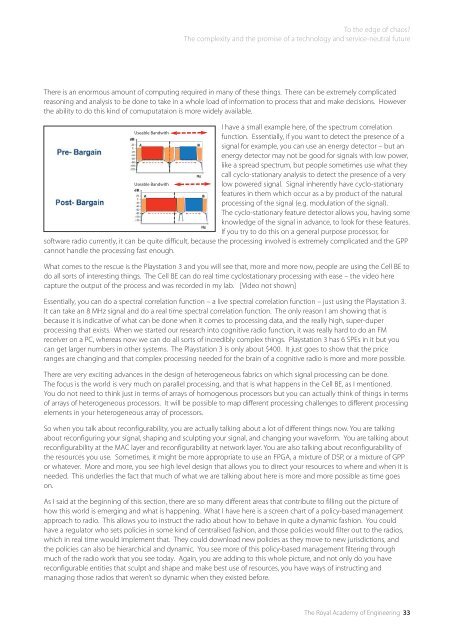Lecture Series in Mobile Telecommunications and Networks (1583KB)
Lecture Series in Mobile Telecommunications and Networks (1583KB)
Lecture Series in Mobile Telecommunications and Networks (1583KB)
You also want an ePaper? Increase the reach of your titles
YUMPU automatically turns print PDFs into web optimized ePapers that Google loves.
To the edge of chaos?<br />
The complexity <strong>and</strong> the promise of a technology <strong>and</strong> service-neutral future<br />
There is an enormous amount of comput<strong>in</strong>g required <strong>in</strong> many of these th<strong>in</strong>gs. There can be extremely complicated<br />
reason<strong>in</strong>g <strong>and</strong> analysis to be done to take <strong>in</strong> a whole load of <strong>in</strong>formation to process that <strong>and</strong> make decisions. However<br />
the ability to do this k<strong>in</strong>d of comuputataion is more widely available.<br />
I have a small example here, of the spectrum correlation<br />
Useable B<strong>and</strong>with<br />
function. Essentially, if you want to detect the presence of a<br />
signal for example, you can use an energy detector – but an<br />
energy detector may not be good for signals with low power,<br />
like a spread spectrum, but people sometimes use what they<br />
call cyclo-stationary analysis to detect the presence of a very<br />
Useable B<strong>and</strong>with<br />
low powered signal. Signal <strong>in</strong>herently have cyclo-stationary<br />
features <strong>in</strong> them which occur as a by product of the natural<br />
process<strong>in</strong>g of the signal (e.g. modulation of the signal).<br />
The cyclo-stationary feature detector allows you, hav<strong>in</strong>g some<br />
knowledge of the signal <strong>in</strong> advance, to look for these features.<br />
If you try to do this on a general purpose processor, for<br />
software radio currently, it can be quite difficult, because the process<strong>in</strong>g <strong>in</strong>volved is extremely complicated <strong>and</strong> the GPP<br />
cannot h<strong>and</strong>le the process<strong>in</strong>g fast enough.<br />
What comes to the rescue is the Playstation 3 <strong>and</strong> you will see that, more <strong>and</strong> more now, people are us<strong>in</strong>g the Cell BE to<br />
do all sorts of <strong>in</strong>terest<strong>in</strong>g th<strong>in</strong>gs. The Cell BE can do real time cyclostationary process<strong>in</strong>g with ease – the video here<br />
capture the output of the process <strong>and</strong> was recorded <strong>in</strong> my lab. [Video not shown]<br />
Essentially, you can do a spectral correlation function – a live spectral correlation function – just us<strong>in</strong>g the Playstation 3.<br />
It can take an 8 MHz signal <strong>and</strong> do a real time spectral correlation function. The only reason I am show<strong>in</strong>g that is<br />
because it is <strong>in</strong>dicative of what can be done when it comes to process<strong>in</strong>g data, <strong>and</strong> the really high, super-duper<br />
process<strong>in</strong>g that exists. When we started our research <strong>in</strong>to cognitive radio function, it was really hard to do an FM<br />
receiver on a PC, whereas now we can do all sorts of <strong>in</strong>credibly complex th<strong>in</strong>gs. Playstation 3 has 6 SPEs <strong>in</strong> it but you<br />
can get larger numbers <strong>in</strong> other systems. The Playstation 3 is only about $400. It just goes to show that the price<br />
ranges are chang<strong>in</strong>g <strong>and</strong> that complex process<strong>in</strong>g needed for the bra<strong>in</strong> of a cognitive radio is more <strong>and</strong> more possible.<br />
There are very excit<strong>in</strong>g advances <strong>in</strong> the design of heterogeneous fabrics on which signal process<strong>in</strong>g can be done.<br />
The focus is the world is very much on parallel process<strong>in</strong>g, <strong>and</strong> that is what happens <strong>in</strong> the Cell BE, as I mentioned.<br />
You do not need to th<strong>in</strong>k just <strong>in</strong> terms of arrays of homogenous processors but you can actually th<strong>in</strong>k of th<strong>in</strong>gs <strong>in</strong> terms<br />
of arrays of heterogeneous processors. It will be possible to map different process<strong>in</strong>g challenges to different process<strong>in</strong>g<br />
elements <strong>in</strong> your heterogeneous array of processors.<br />
So when you talk about reconfigurability, you are actually talk<strong>in</strong>g about a lot of different th<strong>in</strong>gs now. You are talk<strong>in</strong>g<br />
about reconfigur<strong>in</strong>g your signal, shap<strong>in</strong>g <strong>and</strong> sculpt<strong>in</strong>g your signal, <strong>and</strong> chang<strong>in</strong>g your waveform. You are talk<strong>in</strong>g about<br />
reconfigurability at the MAC layer <strong>and</strong> reconfigurability at network layer. You are also talk<strong>in</strong>g about reconfigurability of<br />
the resources you use. Sometimes, it might be more appropriate to use an FPGA, a mixture of DSP, or a mixture of GPP<br />
or whatever. More <strong>and</strong> more, you see high level design that allows you to direct your resources to where <strong>and</strong> when it is<br />
needed. This underlies the fact that much of what we are talk<strong>in</strong>g about here is more <strong>and</strong> more possible as time goes<br />
on.<br />
As I said at the beg<strong>in</strong>n<strong>in</strong>g of this section, there are so many different areas that contribute to fill<strong>in</strong>g out the picture of<br />
how this world is emerg<strong>in</strong>g <strong>and</strong> what is happen<strong>in</strong>g. What I have here is a screen chart of a policy-based management<br />
approach to radio. This allows you to <strong>in</strong>struct the radio about how to behave <strong>in</strong> quite a dynamic fashion. You could<br />
have a regulator who sets policies <strong>in</strong> some k<strong>in</strong>d of centralised fashion, <strong>and</strong> those policies would filter out to the radios,<br />
which <strong>in</strong> real time would implement that. They could download new policies as they move to new jurisdictions, <strong>and</strong><br />
the policies can also be hierarchical <strong>and</strong> dynamic. You see more of this policy-based management filter<strong>in</strong>g through<br />
much of the radio work that you see today. Aga<strong>in</strong>, you are add<strong>in</strong>g to this whole picture, <strong>and</strong> not only do you have<br />
reconfigurable entities that sculpt <strong>and</strong> shape <strong>and</strong> make best use of resources, you have ways of <strong>in</strong>struct<strong>in</strong>g <strong>and</strong><br />
manag<strong>in</strong>g those radios that weren’t so dynamic when they existed before.<br />
The Royal Academy of Eng<strong>in</strong>eer<strong>in</strong>g 33

















